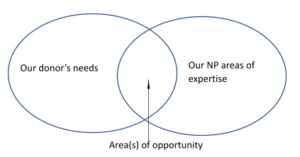
The marketing channel with the highest return on investment is email. It’s been shown that across all industries for every $1 spent, email brings a return of $40. Yes, it is also the most effective channel for fundraising (including a higher ROI than events).
This means that that most effective fundraising starts by growing your subscriber base and using email to turn those subscribers into donors.
However, there is another issue related to the importance of growing your subscribers: email list churn.
The average nonprofit loses 22% – 30% of email subscribers over the course of a year; which means if you aren’t growing your audience at least 30% per year, your reach is shrinking!
That begs the question: how can you consistently add new subscribers so that you can offset email list churn and ultimately grow your donor base?
If you are at a party or conference, and you see someone you want to meet, do you think standing there and hoping they’ll come talk to you is a good strategy to meet them?
No! You find a way to introduce yourself, ask for their name and other questions to get to know them. In other words, the key to starting a relationship with new people is for you to think about them.
If we apply this to growing your donor base, you need to understand your donors and meet them where they are. I believe the best way for nonprofits to attract potential donors is to use your expertise to help them while simultaneously giving them a taste of how you fulfill your mission!
How can you help potential donors? Specifically, I recommend creating a digital resource. Digital content is great for a busy nonprofit leader to get results without a ton of ongoing effort because it is evergreen – an up-front investment to create and then used over-and-over.
If you can offer people something of value to help them, it will give them a reason to subscribe, which is exactly what you need to do to offset list churn and grow relationships that create new donors.
However, creating any digital guide (petition, checklist, infographic, eBook, online course) is not enough to ensure success. You need to make sure that what you create actually solves a problem your potential donors want to solve!
That’s why this article exists and what the 9 questions lead you to – to ensure that you create a resource that your donors find valuable and want to subscribe to get!
9 Questions to Align Your Mission, Fundraising, and More Effectively Attract Donors
The key to content that is valued by your potential donors is to answer these 9 questions, so let’s look at them without further ado:
1. What is your guiding principle?
If you know your guiding principle or core belief, it will guide you on how stay true to your mission even when your situation drastically changes. Your guiding principle gives you a foundation for fundraising, which is the same foundation you can use to attract new donors. For example, if you are an Animal Shelter and your guiding principle is that animals are worth caring for, anything you do to help pet owners be better caretakers of their animals is in line with your principle; any marketing that is an outflow of this principle will automatically align with your mission.
2. What is your expertise?
The easiest way to create a resource is to use your expertise as an organization – the skills, knowledge, and resources that you are already using to fulfill your mission. Doing this is key to help your potential donors in a way that naturally gives them a taste of your mission.
3. Who is your donor and what do they need?
If you understand your potential donors’ needs, then you can create a resource that will serve them. The important thing is to understand their problems as related to your expertise.
4. What is your area of opportunity?
By “area of opportunity”, I mean, where does your expertise overlap with what your donors need?

These first four questions identify where your organization is uniquely positioned to serve people. Once you’ve understood what your areas of opportunity are, it’s time to start validating the demand for your specific resource ideas to make sure they are something your potential donors want and are looking for!
5. What does your team hear or see on the front lines of your mission?
Following question one (what is your guiding principle?), your mission is a great source to show you where you are already well-equipped to serve people. The questions you answer or the problems you are already addressing on the front lines of your mission can give you inspiration for how to help potential donors. Just because your donors are in a different context or situation than those whom you serve through your mission, they are likely asking the same questions or facing the same problems.
6. What are people searching for online related to these issues and questions?
Spend a little time searching Google, YouTube, and social media for the questions that your proposed digital resource could address. How many results do you find? The more you find, the more likely the demand there is. If you search for a potential issue and no relevant results appear, it could be you’ve discovered a unique problem that no one else has solved . . . or more likely there simply isn’t demand for it.
7. Google Keyword Research
An even better tool to research the (quantitative) demand for your proposed resource is to take advantage of a free tool from Google: the Keyword Planner. You can create a Google Ads account (no payment info. required!) and use the built-in Keyword Planner tool to find out how many searches are being made for a specific problem or question. You can narrow down the time frame and locations that are relevant for your organization, enter in keywords your potential donors might search, and find out how many searches were made. The more searches, the more people are looking for the resource you’re planning to create.
8. What does your audience think about resources you’re proposing?
Finally, send a survey to your current audience (via email, text, and social media) and ask people for their opinion on the resource you’re thinking of putting together. Share a few options and ask which they feel would be the most valuable.
9. What digital format should your resource take?
Once you’ve identified your unique place to serve donors, how you can give them a taste of your mission and validated the demand for the specific resource you could create, you are ready to start putting it together! The last question to answer is a straightforward one – what format should you use for your resource? Digital resources come in many formats, including:
- Quiz
- Infographic
- Audio files or Videos
- eBook/checklist/white paper/report
- Petition
- Online course
The simplest way to answer this is to pick the format that will thoroughly address the problem and/or questions that your potential donor have, in a manner that is doable for your team.
If you aim to create an online course, make sure you have the resource to undertake such a big investment. If you want to put together a petition, make sure you have a compelling cause that people want to get behind and a clear goal in sight.
To make this easier, let’s compare three general categories of digital content formats to see the pros and cons of each:
- Petition:
- Pro: easy to create (hours)
- Con: very low conversion rate (avg is less than 0.5%)
- eBook/checklist/white paper
- Pro: low investment of time to create (days)
- Pro: strong conversion rate (avg is 3% – 4%)
- Online course:
- Pro: highest conversion rate (avg is 6% – 8%)
- Con: very high investment of time (weeks, months)
Ultimately, I recommend the “eBook” category as the best type of resource to create, because the ratio of response that you will get (conversions) is worth the low amount of effort needed required to create one.
Once you’ve answered these 9 questions, you will be well-prepared to offer something of value to new potential donors, giving them a taste of your mission in the process. By giving people a reason to subscribe, you will be able to consistently grow your email list and, in the end, your donor base.
If this strategy interests you and you would like to start to implement it in your own organization, download our free eBook and learn a 6-step process to consistently attract donors.

Chris is the author of this article, the founder of Beeline, and has been working with nonprofits since 2015. If you’d like to read more
As the Customer Happiness Director, he and his team aim to help your organization grow your mission and donor base through marketing that aligns with your mission. His top skill is masterfully putting his two youngest boys down for a nap every day.
